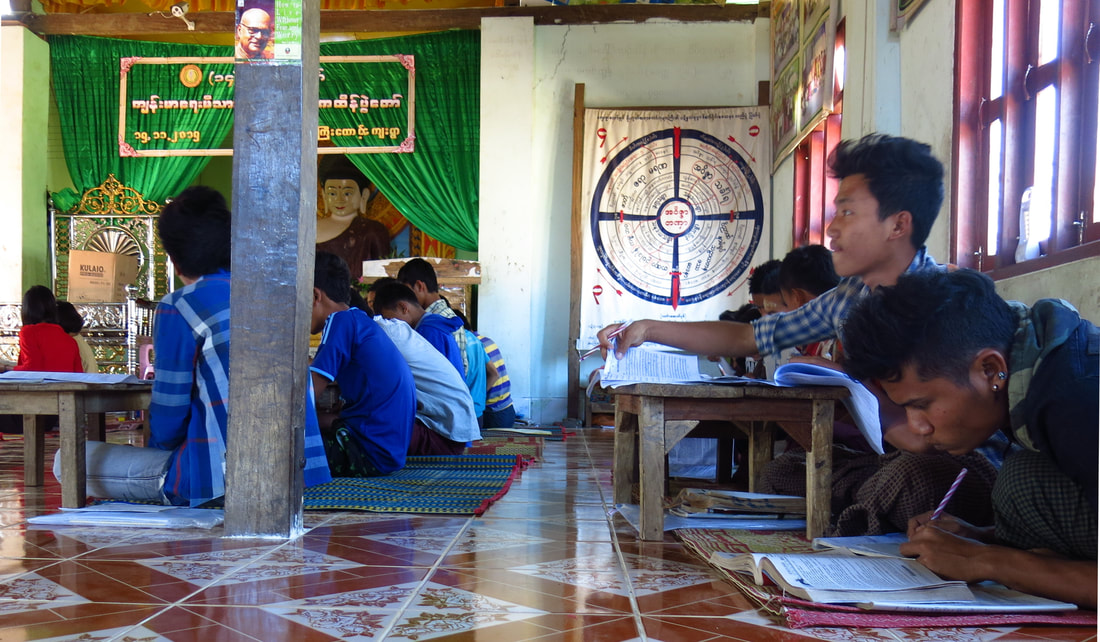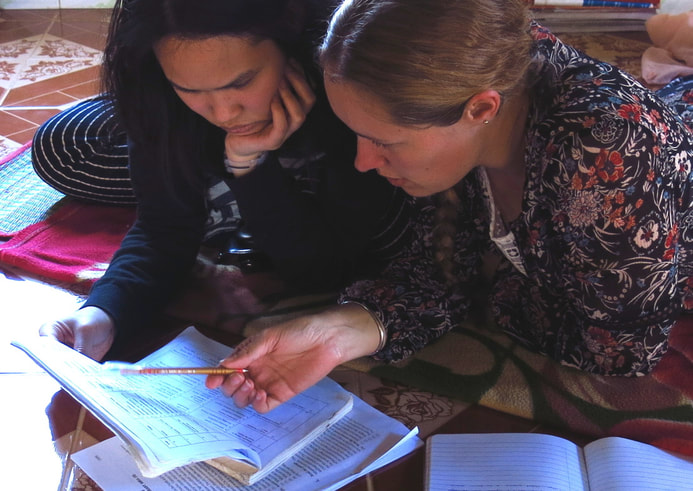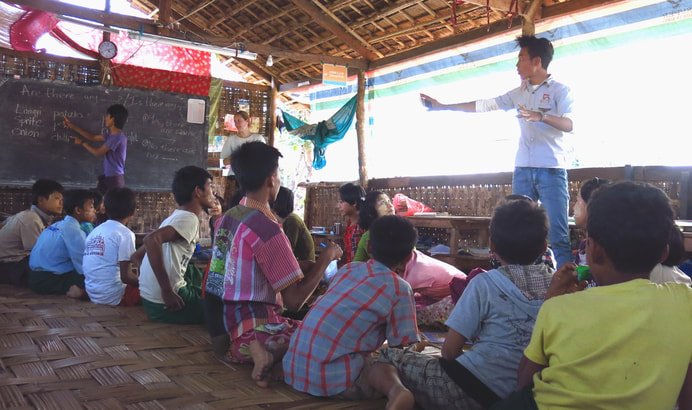|
All was still and quiet. Peering through the windows of the large hall nothing stirred. There was no sound. We had been told that we could observe the head monk’s class but perhaps we had missed it already? With the flexible scheduling it was entirely plausible that something had come up and affected the class. As we entered there was a stillness in the air. Our footsteps resonated across the cool floor as we moved to the back to sit down. There was a class. Or, so it appeared. Perhaps more accurately, we had entered a library. At the front there sat the head monk, crossed-legged, resplendent in his red robe rocking back and forth in a rhythmic motion most unsuited to an active classroom. Most students were sitting bent over small wooden desks, scrawling away on grey-white pieces of paper. Some were reading textbooks. In the hour that we observed, only two pairs of student whispered to each other and the monk spoke for a total of three minutes. This was split into a two-minute fragment and a one-minute giving of answers for the practice matriculation papers that the students were working on. All of the speech was in Arakanese and was delivered at decibels which I believe is hard to hear even if you are a subspecies of super human bat cross who comes complete with sonar built in. The students are scared of the monk and his authority. He does not speak good English, although he is proficient at reading and writing. This is not how a lesson should be run. I even corrected some papers while we observed; the English was pretty good. It also meant that we got to see a copy of the practice matriculation exam. A three-hour long paper which requires sharp knowledge of grammar and the ability to skim and scan long reading passages for essential information. In practice, what the three-hour exam means is that teachers guess the content and then the students learn the answers by rote in the hope that the question comes up on the paper and they can pass with ease. There is no critical thinking involved, nor is there any real study skills learned. Just memorization to pass the exam. There is no understanding or caring how you might use the information other than to fill in the blank gaps that dot the 6 pages of the government issued exam copy. A few days later, the second promising student asked me if he could use the NEH lesson plan for his class later that day. Of course, I readily agreed and arranged to come to the lesson to observe. Why not get started with the feedback loop as soon as possible. The more data we can observe about how lessons are run here, the easier it is to adapt our curriculum and encourage the teachers to strike out and use the new methods of student-centered learning. Not to mention planning! The more that local teachers are exposed to the planning process the better; lessons are not isolated entities which exist in a vacuum. They must fit into the wider jigsaw. We arrived into the grade 9 classroom and proceeded to team-teach our market lesson which we had had great success in the grade 8 scenario. The lesson was not without merit, but it lacked the same enthusiasm that we had eventually found with grade 8. Worryingly, the vocabulary of the grade 9 students was equal to or in some cases worse than the grade 8 pupils! In our feedback session with the local teacher, we enquired as to why this might be. I was slightly confused anyway because I knew that the teacher taught grade 7 and not grade 9; why was he teaching this new grade and who was teaching his class? The grade 9 class belongs to the head monk who likes to ponder and contemplate while not interacting with his class. There are a huge number of students in the grade; 27 in total. While they are calmer and much better behaved than grade 8, it is hard to simply have that many students in such a small space. The monk has often mused that he wants more hours of in-class teaching time for his students; it is not hard to see where this belief comes from when he does not teach but rather observes his students during his classes. On the positive side, we were able to team-teach effectively and the atmosphere in the classroom was one of interaction and engagement with what they were being asked to do. Unlike grade 8, grade 9 seemed to take it in stride that a foreigner was teaching them. Although, our local teacher did suggest that was why they were quiet; because they were nervous and overwhelmed. Chloe Smith NEH Coordinator and Teacher Trainer Related Posts: The Head Monk's Way of Thinking Teaching Discussions with Monks and Lay People Is My English Better Than Yours? The Monk's Funeral Same Goal, Different Ways Observing the Monk's Class Teaching the Head Monk
Comments
|
This section will not be visible in live published website. Below are your current settings: Current Number Of Columns are = 3 Expand Posts Area = 1 Gap/Space Between Posts = 20px Blog Post Style = card Use of custom card colors instead of default colors = Blog Post Card Background Color = current color Blog Post Card Shadow Color = current color Blog Post Card Border Color = current color Publish the website and visit your blog page to see the results |
|
© New Education Highway 2024
Except where otherwise noted, content on this site is licensed under a Creative Commons Attribution 4.0 International License. |




